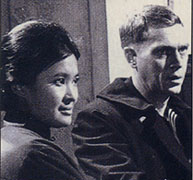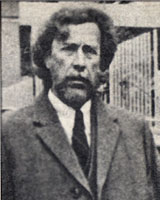Laure is also known as Forever Emmanuelle and, unlike many of the films
with "Emmanuelle" or "Emanuelle" in the title, it has a legitimate claim to be
called a true Emmanuelle film. There is only one legal way that a film could be
called "Emmanuelle" with two "m's" - it would have to be done with the
permission of Emmanuelle Arsan, who personally owned the European and North
American rights to use that name in a film title.
|
 |
But who exactly is "Emmanuelle Arsan"? For years it has been thought to be
the nom de plume of Marayat Bibidh, a Thai woman who was married to a French
diplomat named Louis-Jacques Rollet-Andriane. This theory was substantiated
most strongly by this very film, Laure, in which Mrs. Rollet-Andriane has a
supporting role, under the stage name Emmanuelle Arsan. (She also appeared on
other films as Marayat Andriane, most notably in The Sand Pebbles opposite Steve
McQueen, as shown to the left.) Emmanuelle Arsan is also credited as the
director of this film and the author of its screenplay, based upon an
eponymous novel.
Case proven, right? |
|
Maryat Bibidh |
| Not quite. Mrs. Andriane may have been the actress known as Emmanuelle
Arsan in this film, but she was neither the author nor the director of this film,
nor was she the author of the famous books "Emmanuelle" and "Laure."
According to the producer of this film, she was
simply the beard, and the real author of the Emmanuelle diaries was actually her
husband, the diplomat, who was also the director of this film. He had to write
the books under a pseudonym in order to insulate his softcore porn career from
his career as a diplomat, and when the trail got too close to him, he found it
ideal to claim that his wife was the author. After all, the novels were supposed to
be first person accounts of a woman who was the wife of a diplomat, so she
seemed to the world like the probable author of the stories. |
 |
|
The REAL Emmanuelle! |
In the special features of the Laure DVD, producer Ovidio
G. Assonitis finally reveals the true story. According to Assonitis, it was
Louis-Jacques Rollet-Andriane who directed this film and who wrote the novel
from which sprang his original draft of the screenplay, in both cases using
the name Emmanuelle Arsan. His wife used the same name to perform in the film,
making it seem as if she had also done the writing and directing.
Assonitis was having tea at Fox one day, and they expressed
interest in doing another Emmanuelle film, saying they wished they knew how to
reach the author of the original. Assonitis said, "No problem," found the
Andrianes, got them to agree to their various roles in the project, and Fox
came up with the money. Once filming began, there was a constant conflict between Assonitis and
Rollet-Andriane. The diplomat/author was a notorious proponent of free love
and wanted to use the film's script to advocate the philosophical case for
the lifestyle of sexual abandonment. Assonitis was not interested, and knew
that Fox would not be interested, in a dialogue-intense film which focused on
boring speeches which justified having a variety of sexual partners to perform
a variety of sex acts. He wanted to deliver a film in which those sex acts
were actually portrayed. The two men fought over the film's final cut, and
Rollet-Andriane became so frustrated by his inability to control the project
that he finally asked to have his name removed from the credits.
The final output, whoever may be responsible, is a beautifully photographed
film, shot entirely on location in the Philippines on a leisurely 14 week
schedule, with a generous budget and a guaranteed US release, courtesy of Fox.
The plot:
Laure (Annie Belle) is a free spirit and the daughter of a preacher living
in Manilla. Her vocation is to study social anthropology, at least when she
can make the time between her sex acts. She chances to meet a young
photographer (Cliver) out to document love with his camera, and they become an
item. The anthropology institute run by her father is currently fascinated by
an obscure tribe on a remote island that goes through some rebirth every year,
hence having many lifetimes each lasting one year. Laure decides there must be
an expedition to meet these people and experience the rebirth. Her expedition
team consists of Emanuelle Arsan, a professor, and her photographer, who
marries her before the trip. Everyone has sex with everyone else except the
photographer, who only wants sex with Laure, but enjoys seeing his wife play
around. The professor's wife (Michele Stark) is into the swing scene as well,
but she is not allowed not make the journey because of her pregnancy.
The producers had originally hired the legendary Linda Lovelace for the
part of Laure, but it didn't work out. After Deep Throat, Linda found both drugs and
God, and God told her not to get naked in films anymore. Producer Ovidio
Assonitis also spoke with God, who suggested he fire the bitch, which is how
real-life lovers Al Cliver and Annie Belle got the lead roles. God apparently made the
right call in this case because Annie Belle was not only delightful as a free spirit, but had real
acting talent. Unfortunately, as she mentioned in another one of the DVD's excellent special
features, she was an alcoholic, which probably kept her from a bigger career.
Linda Lovelace's version of the story is that she was originally shown the script
for a mild R-rated film, which she agreed to do, although she was then engaged
to be married
and out of porn, because she had substantial debts and needed the $50,000 fee,
which was a lot of money in the mid 70s. Lovelace and her husband-to-be flew to Rome
to meet with the producer and the director and found that the script had been
altered. "It went from a beautiful thing to pure sleaze," wrote Lovelace in
her autobiography, "Ordeal." "It had me going to bed with twelve different
people. It had me masturbating with camera lenses. Being with lesbians.
Yecccchh!" After Linda refused to do the Laure part, the producer still wanted
her name on the marquee, so the management team demoted her to the part of the
pregnant wife, later played by Michelle Stark. According to Linda the
Andrianes then suggested a foursome with Linda and her husband, with
Louis-Jacques saying, "It's important that we all be with each other
intimately." Both of the Rollet-Andrianes were interested in sex with Linda.
Linda managed to avoid the foursome but continued to
present problems on the set, and finally wrote the writer/director "a short
note complaining about the changes and saying that his writing talent seemed
to be suffering in the tropical heat." Producer Assonitis asked her to
apologize for her remarks to Rollet-Andriane, she refused, and he fired her on
the spot.
Many people have suggested that Linda's accounts of the
past are not completely reliable, so there is no
telling whether we can rely on her memories of this film. Her account
certainly does
make some sense in the context of the struggle between Assonitis and
Rollet-Andriane for control of this script. Presumably Lovelace had originally
been pitched a first draft prepared by Rollet-Andriane in which people talked
about the relationship between sex and spiritual beauty, but was finally
expected to perform in the Assonitis version, in which the talking was
replaced by the actual sex.
Lovelace must have known who the
Rollet-Andrianes were, but I can only surmise that she had been bound by a
strict confidentiality agreement not to disclose their identities, because she
writes only that she was propositioned by "the director and his wife,"
and never mentions either of them by name. She does make it completely clear
in both of her bios ("Ordeal" and "Out of Bondage") that the writer/director
of Laure was a man, so it had been firmly established in 1980 (the publication
date of "Ordeal") that Marayat was not the auteur. By the way, the official "outing" of Louis-Jacques Rollet-Andriane seems to have
occurred way back in the 1960s, even before the first Emmanuelle movie was
made. Joe Bob Briggs pointed out in his 2002 review of
The Sexual Life of Catherine M and his 2001 review of
Emmanuelle in Space:
"After all, the French not only came up with "The Story of O" in the
fifties, but the novel 'Emmanuelle' by Emmanuelle Arsan in the sixties, which
is supposedly a true account of this French wild woman who hung out in
Thailand with her incredibly understanding diplomat husband, who didn't care
who she went to bed with because he believed in "free love," and a bunch of
other rich French people who lived in Southeast Asia and liked to do two
things: a) have sex, and b) make long boring speeches about the meaning of
sex.
De Gaulle himself hated 'Emmanuelle' so much that he tried to get it
banned, and in the course of defending it the publisher had to admit that
there was no Emmanuelle Arsan and that the book had been written by a guy
named Rollet-Andriane.
De Gaulle never got the book banned,
but by the time the film version came out in the early seventies, the new
French president, Georges Pompidou, tried to get the movie
banned."
Despite the revelations from that first censorship attempt some 40 years ago,
and despite Lovelace's clear identification of the director of Laure as a man, all reference books
and all online sources continue to identify Marayat Andriane, not her husband,
as the real author of the Emmanuelle books, perhaps because "Emmanuelle Arsan"
is identified as the writer, director, and co-star of this film, and it
is Marayat who actually appears on screen using that name.

